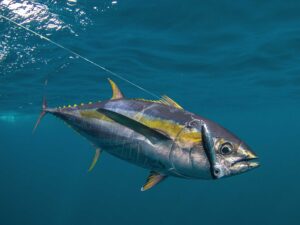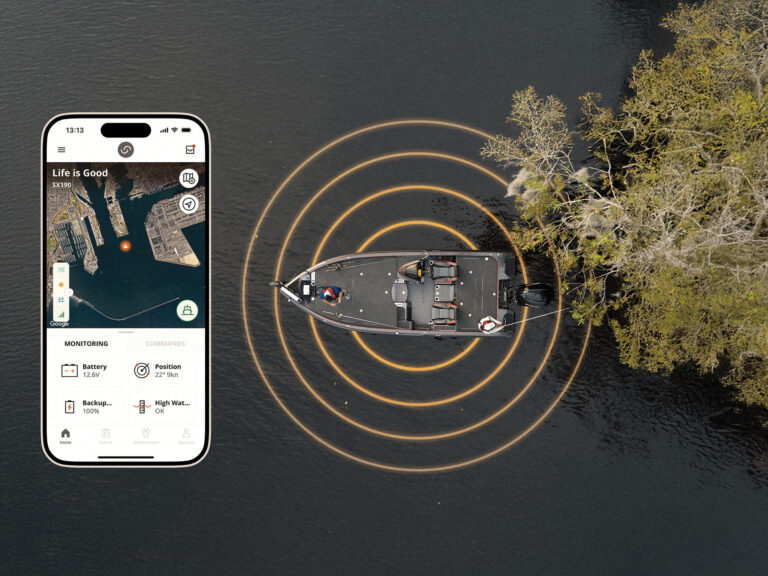When talk turns to fishing offshore oil rigs, the area that most often comes to mind is the Gulf Coast. Visions of game fish like amberjack, kingfish and dorado milling within easy casting distance of “erector sets” makes for a very desirable fishing locale. However, for Southern California residents, a trip to the airport will not be necessary.
Instead, West Coast anglers can find year-round action at any number of these Eiffel Tower-like platforms that dot the south coast shoreline. No, we don’t have amberjack, but yellowtail are close cousins and every bit as strong. Yes, dorado normally stay far to the south, but when water temperatures soar, they become reasonable targets. And there are no kingfish, but equally toothy barracuda do cruise these rigs.
West Coast platforms also host a number of species that the Gulf rigs cannot claim. The mainstay catch here is the calico bass, and thanks to increased hatchery and conservation efforts, catches of white sea bass, the giants of the croaker family, have increased over recent years. Even halibut and roving schools of bonito will bend rods here.
The huge concrete pilings and surrounding structure act like a magnet, attracting a variety of baitfish like anchovies, smelt, perch, tomcod and mackerel. These smaller fish utilize the structure both for protection from larger predators and as an endless source of smaller marine organisms like worms, crabs and mollusks to feed on.
That magnetism, and the fact that even novice boatmen can find the rigs easily, has led them to become prime targets for spin fishermen and plug casters over the past 10 years. Surprisingly, the resource has remained relatively under-utilized by fly fishermen, and that is unfortunate because so many prime California species prove eager to take a variety of fly-rod offerings here. These fish may have been exposed to an array of artificials like spoons, plugs and lead-head/plastic-tail combinations, but they haven’t seen much in the way of traditional flies.
I’ve spent considerable time working the area around these platforms with spinning and conventional gear, and all this accumulated experience has served me well when I venture out to the rigs with fly gear. As in most fishing situations, there are basic principles that apply across the tackle spectrum. At this point, let’s focus on the techniques that fly rodders will want to incorporate when fishing the rigs.
Sinking Lines a Must
You can expect most of the action to take place below the surface, so leave the floating lines at home. For those rare occasions when lure fishermen are drawing strikes by buzzing artificials across the surface, even a fast-sinking line (my first choice for this type of fishing) poses no handicap whatsoever. Simply make the forward cast and begin stripping in the fly the moment it hits the water. At the most, the fly will be only a foot or so in the water column and this is still very much in the strike zone for surface-feeding fish.
Bear in mind that even lines designated as fast-sinking (and this applies even to lead-core lines) do not sink anywhere near as rapidly as a lead-head jig or heavy metal spoon. Rather than plummeting toward the bottom like a rock, these lines tend to slip into the depths like a water-soaked leaf being swept along in a river current.
Ironically, though, rather than acting as an impediment to one’s fishing success, under most conditions at the rigs, the comparatively slow sink rate of fly lines actually works in the fly fisherman’s favor. In this respect, the effect of the line’s rather casual descent rate on the fly’s action functions much like the metal spoon favored by spin fishermen.
A lightweight, chrome spoon wobbles as it makes its way down into the water column. Spin fishermen use it as a fish finder. Because it flutters as it falls, if fish are in the area, regardless of where they may be suspended, they inevitably strike the slow-falling offering. Flies may not incorporate the same fluttering motion of a spoon, but there are patterns with some very enticing actions of their own, and when used in conjunction with sinking lines, their gradual descent will also attract suspended fish.
The fly line that you will find most practical for fishing the rigs is a shooting head. It maximizes distance, and long casts are important under these conditions. First of all, despite the fact that you are working structure, it is nonetheless blind fishing. You’ll want to cover as much water as possible, so the greater the distance you can retrieve your fly in and around structure, the greater the chances that a fish will eventually intercept it.
Another consideration is that of water depth. As is often the case, a long length of running line in conjunction with the shooting head will be required to get the fly into the depths. A 40-foot depth may require 80 or more feet of line and this will have to be achieved with the cast.
Lastly, from the standpoint of safety, it’s good practice to stay at least 50 feet or so away from the platform. If there are strong currents or swells, you may have to back away even farther. That means placing the fly in the most productive zones right alongside the pilings often necessitates fairly long casts.
Keep Leaders Simple
Obviously the fly line is the critical factor in determining the fly’s rate of descent, but there are two additional variables that need to be considered. One is the leader setup. The rule of thumb when using a sinking line is to keep the leader relatively short, about 3 feet or so. A long leader will tend to sag and this will impede the fly’s descent.
I keep the leader system for this type of fishing very simple. With the exception of occasional roving schools of barracuda and bottom-hugging halibut, the fish you’ll encounter at the rigs do not have the kind of dental structure that requires a shock leader. While it’s true that a heavy shock tippet will save some flies when you’re working patterns in and around barnacle-encrusted rocks and pilings, these fish are often leader-shy, so you’ll experience more strikes by tying the fly directly to the class tippet.
There are also compromises in the choice of the class tippet’s breaking strength. Because you’re fishing structure, it makes sense to opt for heavier tippets like 16- and 20-pound test to keep fish out of the line-cutting barnacles. The trade-off, of course, is that the heavier, larger diameter lines will not draw as many strikes. For most situations, I take my chances and fish with 12-pound-test tippets. If the water is off-color or the fish are exceptionally responsive, I’ll move up to 16-pound test.
Often, I forego the use of a butt section and connect the class tippet directly to the end loop in the shooting head. Because fish around the rigs (calicos in particular) have a penchant for striking an offering as it falls into the depths, I often use a fixed loop knot. The loop allows the fly to swing freely on its descent, simulating the natural dive patterns of injured baitfish.
Fly Choice is Critical
Another important variable in fishing the rigs is the fly pattern, and I have four favorites.
The virtues of the Clouser Minnow have been extolled by just about everyone who has ever fished it, and when I want to get a fly down along the platform pilings, this is the pattern I usually turn to. The Clouser is a basic baitfish simulator, and in the weighted version, it is an ideal pattern for working the submerged structure that surrounds the oil rig platforms. Because the hook point rides up, there is less chance of the fly fouling on any of these obstructions. Depending on the weight of the eyes that you select, the Clouser can be tailored to fish a variety of depths. However, I especially like it for deep-water applications because the weight-forward profile causes the fly to dip and dive on the retrieve, very much like a jig. The resulting action can prove irresistible to a host of game fish.
Since anchovies and smelt are common baitfish in these waters, I always tie the Clousers with a white underbelly and fairly dark top that will feature different shades of blue and green. A few strands of silver Mylar between the belly and topping simulates the baitfish flash that is particularly characteristic of anchovies when they are milling around structure.
Two other East Coast patterns work well when the fish are holding in about 10 feet of water. The first is Bob Popovics’ Cotton Candy. The fly is tied with Big Fly Fiber and combed-out wool that is covered with a light application of silicone dressing. Fished with a stop-and-pause retrieve, the undulating characteristics of the Big Fly Fiber in conjunction with the water-displacing silicone head gives this fly a pulsating action that is absolutely seductive.
Due to its silicone head, the fly tends to be somewhat buoyant, but with a fast-sinking line it will slip into the depths very much like squid do when they’re not aroused. If you want to fish the Cotton Candy deep, simply tie a pair of dumbbell eyes (I like 7/32 and 8/32 sizes for this fishery) immediately behind the eye of the hook and use a very light application of silicone.
Another pattern that can generate a lot of excitement at the rigs is a creation from Long Island tier Joe Blados that he calls his Crease Fly. Made from foam sheets cut to the shape of baitfish, Blados’ fly was designed to be fished on the surface with floating lines. Used in this manner with a very slow retrieve, it makes for a highly convincing imitation of a wounded baitfish. I have begun fishing the Crease Fly with sinking lines and found that it is very effective down in the water column. When fish are feeding on anchovies or smelt and are not suspended too deep, this fly will produce more than its share of solid strikes.
Dale Hightower’s Tres Generation Fly that I described in the March/April 1999 issue of this magazine has also proven very effective both on barracuda and calico bass. This is a translucent pattern and when the sun is bright, it looks like an underwater glow light. Barracuda especially are well known for their love of flashy offerings and they’ll eat this fly like candy. The epoxy coating makes this a very durable fly even with tooth-studded predators, though you will lose a few to the local ‘cudas. Small-diameter, single-strand wire would seem a logical choice for this fishing, but often the barracuda get leader-shy and for consistent action you’ll have to tie the fly directly to the class tippet.
Working the Rigs
California’s oil rigs may be easy to locate, but proper boat handling remains a critical part of this fishing. If you are not adept at maneuvering a boat in and around structure, these platforms are not the place to fish. Both from the standpoint of safety and fishing success, you are much better served with the services of a guide.
Fish suspended around the platforms can spook easily so this structure should be approached as quietly and carefully as possible. If there are other boats in the area, take a little time to study them as a frame of reference. By carefully observing other craft, you can often gauge the strength and direction of the current. Try to establish a drift pattern that allows you to cast parallel to the platform’s pilings. If possible, shut the engine off.
Be aware of the fact that some fish do not always confine themselves strictly to the rigs. They are constantly alert for food sources and they’ll move away from the platform in search of other structure that can provide a future meal. For that reason, a good fish finder is a must here.
Once you’ve located the additional structure, you can save yourself a lot of wasted fishing time by dropping a marker buoy on it. With the buoy as a reference, you can work the area thoroughly. Sometimes it takes a while experimenting with different flies, color patterns and retrieve rates, but with persistence you’ll eventually hit the right combination. Of course, what makes this such a challenging proposition is the fact that what produced one day may not do so the next time out.
When you are fishing this type of habitat, pay particular attention to the line as it begins to make its descent at the conclusion of the forward cast. When a fish grabs a sinking fly the strike can be quite subtle. It is during this phase that the fly fisherman is at a distinct advantage because the line is hand-held and the slightest interruption in the fly’s descent is immediately telegraphed to the angler. However, to maximize this advantage, strike with the line and not the rod. If you come up with the rod, there is a good chance that you will pull the fly away from the fish.
For this reason, I recommend a two-handed retrieve with the rod tucked between the arm and torso. Manipulating the retrieve with two hands affords better line control and will force you to strike with the line. This technique is also very effective when trying to muscle a fish out from the pilings. It’s much easier to maintain pressure with two hands cradling the line instead of just one. Furthermore, it’s often necessary to hand-strip the fish away from structure and this can be accomplished more quickly and securely by using both hands in rapid succession.
Do not make the mistake of trying to reel up any excess line that may be lying at your feet. The first order of business is to try and turn the fish away from the structure. Attempting to maintain pressure on the fish by clamping the line against the rod with one hand while winding in line with the other is seldom successful. Even if you are using the traditional one-handed style, continue to try to move the fish your way by hand-stripping the line. This is literally a touch-and-go situation. If you apply too much pressure, you’ll pop the tippet. But if the fish gets its way, it will very likely cut you off on a piling or cable.
The plus-side to all this, though, is that instead of pondering the situation on a long plane ride to the Gulf Coast, you can think about it on your way out to the fishing grounds right here at home.









